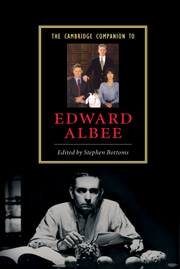Book contents
- Frontmatter
- 1 Introduction
- 2 Albee’s early one-act plays
- 3 Who’s Afraid of Virginia Woolf?
- 4 “Withered age and stale custom”
- 5 Albee’s 3½
- 6 Albee’s threnodies
- 7 Minding the play
- 8 Albee’s monster children
- 9 “Better alert than numb”
- 10 Albee stages Marriage Play
- 11 “Playing the cloud circuit”
- 12 Albee’s The Goat
- 13 “Words; words... They’re such a pleasure.” (An Afterword)
- 14 Borrowed time
- Notes on further reading
- Select bibliography
- Index
- Series List
6 - Albee’s threnodies
Box-Mao-Box, All Over, The Lady from Dubuque, and Three Tall Women
Published online by Cambridge University Press: 28 May 2006
- Frontmatter
- 1 Introduction
- 2 Albee’s early one-act plays
- 3 Who’s Afraid of Virginia Woolf?
- 4 “Withered age and stale custom”
- 5 Albee’s 3½
- 6 Albee’s threnodies
- 7 Minding the play
- 8 Albee’s monster children
- 9 “Better alert than numb”
- 10 Albee stages Marriage Play
- 11 “Playing the cloud circuit”
- 12 Albee’s The Goat
- 13 “Words; words... They’re such a pleasure.” (An Afterword)
- 14 Borrowed time
- Notes on further reading
- Select bibliography
- Index
- Series List
Summary
Since the beginning of Albee's career, his plays have been pervaded by arresting and memorable images of death. Grandma scoops sand over herself with a toy shovel as she succumbs to the smiling angel of death in The Sandbox (1960). The nurse complains that “the nigger brought a dead woman here” in The Death of Bessie Smith (1960). George makes the “flores para los muertos” allusion and reads the Catholic Requiem liturgy after the death of the imaginary son in Who's Afraid of Virginia Woolf? (1962). During the late 1960s and 1970s, Albee's interest in death and dying intensified, and he produced a series of plays that explored the process of dying, and the experience of the survivors who witness it, in Box and Quotations from Chairman Mao Tse-Tung (1968), All Over (1971), and The Lady from Dubuque (1980). Of these plays, All Over and The Lady from Dubuque are rare twentieth-century dramas in the mode of the threnody, the funeral dirge or song of lamentation. Another decade later, in Three Tall Women (1991), Albee returned to the threnody in a very different frame of mind.
- Type
- Chapter
- Information
- The Cambridge Companion to Edward Albee , pp. 91 - 107Publisher: Cambridge University PressPrint publication year: 2005

